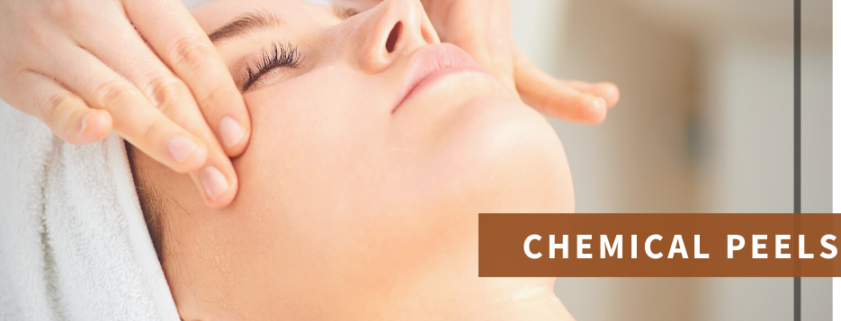CHEMICAL PEELS
For ages, people have tried various methods for healthy-looking skin and are in a constant quest for a better one. The earliest description of the use of chemical peeling dates to ancient Egyptian times in 1550 BCE. The modern history of the use of chemical peel began in 1871 with William Tilbury Fox.
After all this time, chemical peel remains one of the commonest, effective, and safe ways to fight signs of early ageing and cutaneous concerns especially photoaging, acne and pigmentary disorders.
There are a lot of chemical peels available in the market of varying compositions, combinations, and strengths.
Here are some most asked and wondered questions answered about chemical peels for skin.
- What is a chemical peel?
A chemical peel is a skin resurfacing procedure, in which a chemical is applied to the skin to remove the top layers of skin, resulting in smoother skin. The chemicals used are acids derived from organic products, mainly Alpha-hydroxy acids (AHAs), Beta-hydroxy acids (BHAs), Retinol and various others.
Depending on the depth of penetration, chemical peels are classified as: Superficial, Medium and Deep peels.
Common chemical peels used include:
- Glycolic acid peels
- Black peel
- Mandelic acid
- Various combination and sequential peels
- What are the uses and benefits of getting a chemical peel done?
Chemical peels can be done to target:
- Wrinkles
- Sun damage
- Pigmentary issues including melasma
- Skin dullness
- Uneven tone and texture
- Acne vulgaris
- Acne scarring and pigmentation
- Superficial scars
- For skin rejuvenation and antiaging
- How is it performed?
The procedure may vary depending on the chemical peel chosen.
Before getting a chemical peel, you might need to prime your skin for 2 to 4 weeks. It may or may not be needed depending on your skin condition.
On the day of the peel,
- Your skin is prepped by cleansing your skin.
- Chemical agent is then applied evenly on your skin for a certain time. The contact time depends on the chemical peel used.
- During this time, you might feel a little stinging sensation, which is temporary and subsides
- Some chemical peels may need to be neutralised and may be left on skin for longer time.
Some peels may be left on for a few hours before washing it off
- What will my skin feel like after a chemical peel?
Just after chemical peel, your skin will feel little tight and slight redness. In next few days it can feel little dry and flaky.
- What is the recovery time for a chemical peel?
Recovery times will vary based on the type and strength of the peel. Immediately after the peel, your skin will feel tight and may be a little red. Any visible peeling will be light and fluffy and easily controlled with moisturizer. Peeling usually lasts 3-5 days, depending on the actual peel treatment.
- Why I did not have visible peeling?
Visible peeling depends on the peel used and individual skin condition. Regardless of degree of peeling, the skin turn-over rate is increased, resulting in skin tone and texture improvement.
- How often can I get a chemical peel done?
The frequency of chemical peels depends on the type of peel and the condition of your skin. Superficial peels can be done as often as every 2-4 weeks.
- How many sittings are needed?
Usually, 6 to 8 sitting. But it can vary depending on the peel used and your skin condition.
- How long do the results last?
After initial 5 to 6 sittings, one needs maintenance sittings every 3 to 6 months depending upon the condition.
- Risks and side effects?
Certain individuals are more prone to side-effects than others, including darker skin individuals and who have history of keloid formation.
Immediate side-effects can include: redness, irritation, itching, swelling and blistering.
Delayed side effects can include: prolonged erythema, and hyper pigmentation, if there is excessive sun exposure. Rarely, skin infection, if medium or deep peels are used.
proper maintenance of the skin after a chemical peel, and avoiding excess sun exposure for the first several weeks afterward to maximize results and prevent complications
- Are there any side-effects in the longer run?
Chemical peels are absolutely safe in the longer run, they are beneficial due to their rejuvenating and antiaging effects.
- What should you avoid before a chemical peel?
Avoid getting any salon facials and cosmetic procedure done. Avoid any laser treatments on the area to be treated.
Avoid any retinoids, AHAs and BHAs, scrubs or any other exfoliating agent, 2 to 3 days before your appointment.
- What should you do before a chemical peel?
Start moisturizing and dedicatedly follow sun protection including use of a sunscreen.
- How should I care for my skin after getting a chemical peel?
- Avoid the Sun for one week and use sunscreen regularly
- Avoid scratching the skin as it is very sensitive
- Use hydrating moisturizer
- Drink plenty of water
- Avoid hot shower baths, hot tubs and saunas for next 2 days
- Avoid strenuous exercise for next 2 days
- Use your skin care products and make up as advised by the doctor
- Avoid Waxing, tweezing and depilation for next 5 to 7 days
- May I exercise after the peel?
Avoid strenuous exercise for next 2 days
- Who should avoid a chemical peel?
- Individuals with history of an allergic reaction to a peeling agent
- Ongoing infection, open wounds in the area of the peel
- Recent isotretinoin use in the last 6 months (particularly relevant to medium and deep peels)
- Patients who are pregnant or breastfeeding
- Patients with psoriasis, connective tissue diseases, atopic dermatitis, exposure to radiation therapy, or who had recent facial surgery are generally not candidates for chemical peeling.

